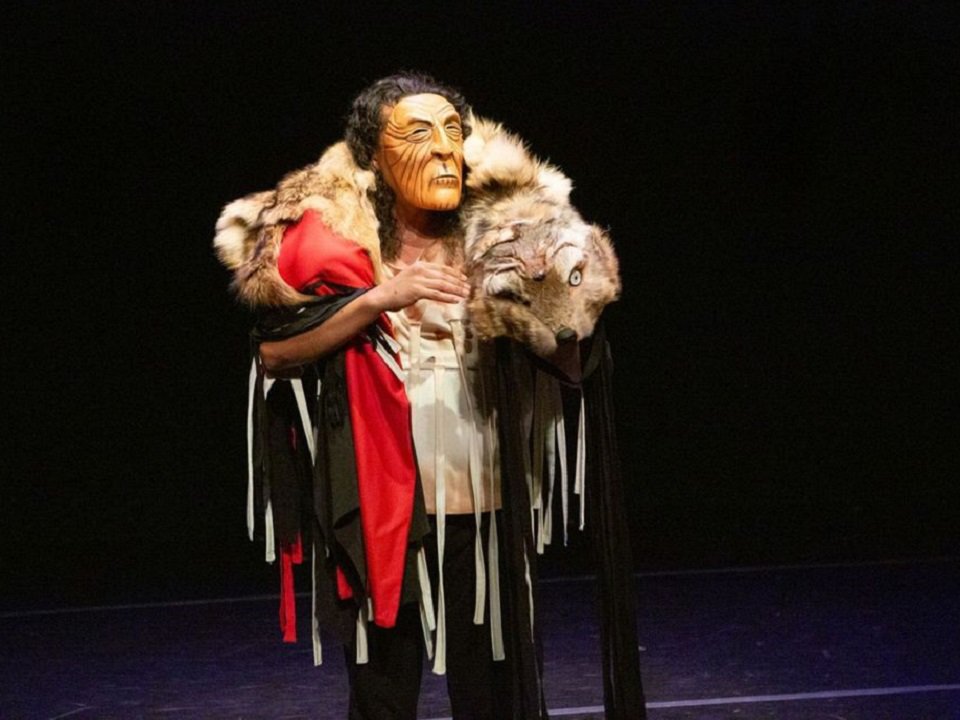Kanopy Dance’s current program, “Polaris,” onstage at the Overture Center’s Promenade Hall through Oct. 12, connects its audience to ancestral wisdom through the power of Ojibwe myth and masked dance. That’s particularly true in the dance Wolf: A Transformation, choreographed and narrated by Daystar (Rosalie Jones), of Pembina Chippewa-Cree ancestry.
Daystar founded the first Native American modern dance company right here in Wisconsin. Wolf was developed at ChaliceStream, the northern Wisconsin dance studio of Barry Lynn and Michael Doran (Lynn was a primary mentor for Daystar, along with José Limón and Reid Gilbert, from whom Daystar learned mime and masking when Gilbert had a studio in Spring Green). In a Thursday evening pre-concert talk featuring Daystar and Daniel Fetecua Soto, the solo dancer of Wolf, Daystar told the Madison audience, “I’m very much feeling at home.”
Key elements of Wolf are two masks custom-made for Fetecua by Hopi sculptor Timothy Talawepi, a wolf headpiece sculpted for him by Olivia Kim, a wolf costume and regalia created by Daisy Payero, and music by Dik Darnell.
How does a dancer wearing a mask make it come to life, face twitching, eyes cutting this way and that? How does a dancer portraying Original Man in an Anishinaabe creation myth transform into the wolf keeping the man company, the wolf’s nose questing, its head swiveling? How does the dancer help us see the leaping spirit within Original Man? These are challenges Daystar sets before the dancer of Wolf. I was reminded of Sierra Leonean masked and costumed persons who channel the power of ancestors and in effect become earthly manifestations of ancestral spirits. In this dance Fetecua became both Original Man and Wolf, his companion, channeling the threat and hope of ancestral wisdom for today’s children.
During the performance, Daystar narrates the Ojibwe myth based on the telling by Edward Benton-Banai in The Mishomis Book. We hear wolf howls, a heartbeat drum, and a large-eyed young Original Man appears in the world’s arena, stepping in the manner of the intertribal southern straight dance, evoking the loping and crouching of the wolf, interweaving modern dance and mime. Original Man transforms into Wolf and then reemerges, the music uncanny and electronic. He mimes, leaps, prowls and transforms again. Carefully, caressingly, he inhabits Wolf’s identity, to drums, chanting and storm sounds. Then in a flash of theater magic he becomes Original Man, older, face lined, eyes heavy-lidded. Entranced by the melding of young Original Man and Wolf, I was shocked by this change to an older Original Man, who knows suffering and compassion for the fate of the original people and the wolves.
Wolf: A Transformation is the centerpiece of the evening, a work of poetic concision, which like a great work of music resonates after it is over. I recommend that Kanopy delay playing any other music for a minute afterwards so the audience can soak in the experience.
This extraordinary evening of dance begins with a witty, beautiful work by Kanopy’s co-artistic director Robert E. Cleary: Rain Brings Change. Kanopy company dancers dazzle in synchrony in silky flower child costumes created by David Quinn, portraying 1960s Summer of Love innocence and joy, followed by the cynicism of the 1970s, told in body language conveying put-downs and disillusionment.
Fetecua followed Wolf with his solo dance Pacha-Mama. Alone onstage, Fetecua moves in blue-green light like the beating heart of Mother Earth to Pablo Mayor’s music. His movement is exuberant, unrefined; his shirt unbuttoned, chest bare. The music features an African xylophone and a cascading rainstick. After rooting himself in nature and culture, he acquires his only two props, a white handkerchief and a straw hat, and we go from the Amazon to the mean streets of New York City, the sound of a jazz sax accompanying the change.
Although he brings Colombian romance and rhythm into New York, he is forced to brush away, or so it seemed to me, anti-immigrant hostility, with kicks, pirouettes and elegant shakes of the hips. The dancer combines village and city, immigrant and urban America, traditional Colombian dance, American modern dance and German tanztheater into a glorious salute to Pacha-Mama, spirit of Mother Earth. Fetecua’s solo has moments that astonish.
Fetecua choreographed the final piece of the evening, Rejoice: Returning Home, for the Kanopy company of dancers who portray bird wings beating the air, frogs hopping, butterflies flapping, a menagerie of nature emerging from the swirl of creation. Dancers evoke creation by gliding as mysteriously as ducks, upper bodies still, legs churning furiously, creating a paradox of effortless energy. Influenced by the concept of the medicine wheel, the dance portrays the cycle of generations. It begins with a terrific lighting effect: as if filtered by a forest canopy, light spears into mist. Village children play games, grow to young adults and fall in love amid blue and pink nightclub lighting. Then Edward Salas takes control of the stage in a solo of heartbreaking tragedy. Throughout the work, dancers allude to the four regions of Colombia in many vignettes of growth of generations and in the work’s finale of harmony, in which they dance around the village tree.
The New York Public Library for the Performing Arts is recording the entire Friday evening concert for the Jerome Robbins Dance Division Archives. Friday’s concert will also feature a concluding dance, Legacy of the Dream, choreographed and performed by Daystar. This is a great opportunity to see Daystar dance. Performances are 7:30 p.m on Oct. 11, and at 3 and 7:30 p.m. on Oct. 12. Tickets at overture.org.


